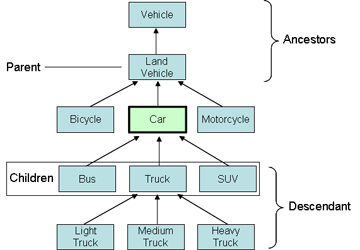CSC/ECE 517 Spring 2013/ch1a 1e pi: Difference between revisions
No edit summary |
No edit summary |
||
| Line 4: | Line 4: | ||
<Index> | <Index> | ||
Means of achieving inheritance | === Means of achieving inheritance === | ||
'''Classical Inheritance''' | |||
Objects are defined by classes, classes can inherit attributes and behavior from pre-existing classes called base classes, superclasses, or parent classes. The resulting classes are known as derived classes, subclasses, or child classes. The relationships of classes through inheritance gives rise to a hierarchy. | |||
[[File:Inheritance(Classical Inheritance).png]] | [[File:Inheritance(Classical Inheritance).png]] | ||
'''Prototype Based Inheritance''' | |||
A feature of object-oriented programming in which classes are not present and inheritance is performed via a process of [http://en.wikipedia.org/wiki/Cloning_(programming) cloning] existing objects that serve as [http://en.wikipedia.org/wiki/Prototype prototypes] . [http://en.wikipedia.org/wiki/Delegation_(programming) Delegation] is the language feature that supports prototype-based programming. | |||
==References== | |||
<references/> | |||
1. [http://en.wikipedia.org/wiki/Prototype-based_programming] | |||
2. [http://en.wikipedia.org/wiki/Delegation_(programming)] | |||
3. [http://en.wikipedia.org/wiki/Cloning_(programming)] | |||
Revision as of 14:34, 8 February 2013
Inheritance
In object-oriented programming (OOP), inheritance is a way to reuse code of existing objects, or to establish a subtype from an existing object, or both
<Index>
Means of achieving inheritance
Classical Inheritance Objects are defined by classes, classes can inherit attributes and behavior from pre-existing classes called base classes, superclasses, or parent classes. The resulting classes are known as derived classes, subclasses, or child classes. The relationships of classes through inheritance gives rise to a hierarchy.
Prototype Based Inheritance A feature of object-oriented programming in which classes are not present and inheritance is performed via a process of cloning existing objects that serve as prototypes . Delegation is the language feature that supports prototype-based programming.
References
<references/>
1. [1]
2. [2]
3. [3]
